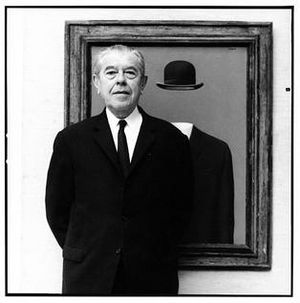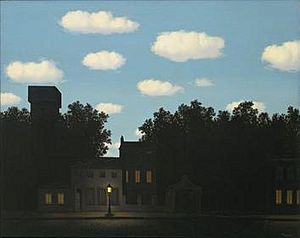René Magritte facts for kids
Quick facts for kids
René Magritte
|
|
|---|---|

Portrait of Magritte in front of his painting The Pilgrim, taken by Lothar Wolleh in 1967
|
|
| Born |
René François Ghislain Magritte
21 November 1898 Lessines, Belgium
|
| Died | 15 August 1967 (aged 68) Brussels, Belgium
|
| Known for | Painter |
|
Notable work
|
The Treachery of Images The Son of Man The Human Condition Golconda The Menaced Assassin |
| Movement | Surrealism |
| Signature | |
René François Ghislain Magritte (born November 21, 1898 – died August 15, 1967) was a famous Belgian surrealist artist. He was known for painting everyday objects in strange and unexpected ways. His art often made people think about what is real and how we see things. His unique style has influenced many other art movements, like pop art, minimalist art, and conceptual art.
Contents
Early Life of René Magritte
René Magritte was born in Lessines, Belgium, in 1898. He was the oldest of three brothers. His father, Léopold Magritte, was a tailor. His mother, Régina, was a hatmaker before she married. René started taking drawing lessons when he was about 12 years old. Sadly, his mother passed away when he was 13.
Magritte's Art Career
Magritte's first paintings, around 1915, looked like Impressionism art. From 1916 to 1918, he studied art in Brussels. However, he found the lessons boring. His early paintings from 1918 to 1924 were influenced by Futurism and Cubism.
In 1922, Magritte married Georgette Berger. He had first met her when they were children. That same year, a poet showed Magritte a painting called The Song of Love by Giorgio de Chirico. Magritte was deeply moved by it. He said it was "one of the most moving moments of my life." He felt his eyes "saw thought for the first time."
From 1922 to 1926, Magritte worked as a designer for wallpaper, posters, and advertisements. In 1926, he painted his first surreal artwork, The Lost Jockey. He had his first art show in Brussels in 1927. But critics did not like it.
Feeling sad about the show's failure, Magritte moved to Paris, France. There, he became friends with André Breton, a leader of the Surrealist group. Magritte's version of Surrealism often showed dream-like scenes. He became an important part of the movement. In 1929, he showed his art with other famous surrealist artists like Salvador Dalí and Joan Miró.
In 1929, Magritte also wrote an essay called "Les mots et les images" (Words and Images). It explored how words and pictures play together, just like in his famous painting The Treachery of Images.
When his art contract ended, Magritte returned to Brussels in 1930. He went back to working in advertising with his brother, Paul. This helped him earn a living. Magritte was also interested in politics and joined the Communist Party of Belgium for some years.
In 1936, he had his first solo art show in the United States. Later, in 1938, he had a show in London. During this time, a British art collector named Edward James let Magritte live in his London home. Magritte painted two famous portraits of James in 1937.
During World War II, when Germany occupied Belgium, Magritte stayed in Brussels. For a short time in 1943–44, he changed his painting style. He used brighter colors, which is known as his "Renoir period." He did this to react to how he felt living in occupied Belgium.
After the war, Magritte signed a paper called Surrealism in Full Sunlight. It showed he was moving away from the sad feelings of his earlier art. For a short time in 1947–48, he painted in a bold, rough style called "Vache period." To earn money during tough times, he also made fake paintings by other artists like Pablo Picasso. He did this with his brother and a friend. By the end of 1948, Magritte returned to his well-known surrealist style.
Magritte's art has been shown in many big exhibitions around the world. These include shows at the Museum of Modern Art in New York and the Centre Georges Pompidou in Paris.
Magritte's Personal Life
René Magritte married Georgette Berger in June 1922. Georgette was the daughter of a butcher. They first met when she was 13 and he was 15. They met again seven years later in Brussels. Georgette, who also studied art, became Magritte's model, inspiration, and wife.
René Magritte passed away from pancreatic cancer on August 15, 1967, at the age of 68. He was buried in Schaerbeek Cemetery in Brussels.
Magritte's Art Style and Ideas

It is a union that suggests the essential mystery of the world. Art for me is not an end in itself, but a means of evoking that mystery.
Magritte's paintings often show everyday objects in strange places. This gives new meanings to things we usually know well. A great example is his painting, The Treachery of Images. It shows a smoking pipe with the words "Ceci n'est pas une pipe" ("This is not a pipe") written below it. This might seem confusing, but it's true: the painting is an image of a pipe, not a real pipe you can smoke! When asked about it, Magritte said you couldn't fill the painting with tobacco.
Magritte also painted surreal versions of other famous artworks. For example, in Perspective I and Perspective II, he copied famous portraits but replaced the people with coffins.
Magritte wanted to create poetic images by putting ordinary objects in unusual settings. He said painting was "the art of putting colors side by side" so that familiar things like the sky, people, trees, or furniture come together in a "poetically disciplined image." He believed the poetry of his images did not need any hidden meanings.
Artists Influenced by Magritte
Many modern artists have been influenced by René Magritte's interesting ideas about images. Some artists who have been inspired by his work include Andy Warhol, Jasper Johns, and Duane Michals. Some of their artworks directly refer to Magritte's paintings. Others offer new ideas based on his themes.
Magritte's use of simple, everyday images has been compared to pop-art artists. His influence on pop art is widely recognized. However, Magritte himself did not think they were very similar. He felt pop artists showed "the world as it is," which he called "their error." He was more interested in "the feeling for the real, insofar as it is permanent." An exhibition in 2006–2007 explored the connection between Magritte and modern art.
Magritte's Legacy
In the 1960s, more and more people became aware of Magritte's art. Because he was so good at showing objects in a thought-provoking way, his works have often been used in advertisements, posters, and book covers.
Many album covers have used his art. For example, The Jeff Beck Group's album Beck-Ola used Magritte's The Listening Room. Jackson Browne's album Late for the Sky was inspired by The Empire of Light. The band Punch Brothers used The Lovers for their album The Phosphorescent Blues.
The logo for The Beatles' company, Apple Corps, was inspired by Magritte's painting Le Jeu de Mourre. Paul Simon wrote a song called "Rene and Georgette Magritte with Their Dog after the War". It was inspired by a photo of Magritte. The movie poster for The Exorcist was also inspired by Magritte's The Empire of Light.
Magritte's art has inspired many filmmakers. His paintings have even been featured in movies like The Thomas Crown Affair, where The Son of Man was a key part of the story.
A street in Brussels has been named Ceci n'est pas une rue (This is not a street), a playful nod to his famous pipe painting.
Magritte Museums and Collections
The Magritte Museum opened in Brussels on May 30, 2009. It is located in a beautiful old building and displays about 200 of Magritte's original paintings, drawings, and sculptures. These include famous works like The Return and The Empire of Light. This museum has the largest collection of Magritte's work anywhere. Much of it came from his wife, Georgette Magritte. The museum also shows his early photographs and short surrealist films.
Another museum is located at 135 Rue Esseghem in Brussels. This was Magritte's home from 1930 to 1954. In 2009, a painting called Olympia (1948) was stolen from this museum. It was a portrait of Magritte's wife. The painting was returned in 2012.
The Menil Collection in Houston, Texas, also has a very important collection of Magritte's art. It includes many oil paintings, drawings, and sculptures. Famous paintings like The Meaning of Night and Golconda are part of this collection.
Selected Works by René Magritte
- 1926 The Lost Jockey
- 1927 The Menaced Assassin
- 1928 The False Mirror
- 1929 The Treachery of Images
- 1933 The Human Condition
- 1935 The Portrait
- 1937 Not to be Reproduced
- 1938 Time Transfixed
- 1940 The Return
- 1948 The Red Model
- 1951 David's Madame Récamier (a parody)
- 1952 Personal Values
- 1953 Golconda
- 1954 The Empire of Light
- 1955 The Mysteries of the Horizon
- 1958 Hegel's Holiday
- 1959 The Castle in the Pyrenees
- 1963 The Great Family
- 1964 The Son of Man
- 1965 Le Blanc-Seing (Carte Blanche)
- 1966 The Pilgrim
See also
 In Spanish: René Magritte para niños
In Spanish: René Magritte para niños
- Magritte Museum, part of the Royal Museum of Fine Arts of Belgium.
- René Magritte Museum, a museum in Jette in Brussels, in the house where Magritte lived and worked for 24 years, between 1930 and 1954.
- List of Belgian painters
- List of paintings by Rene Magritte

